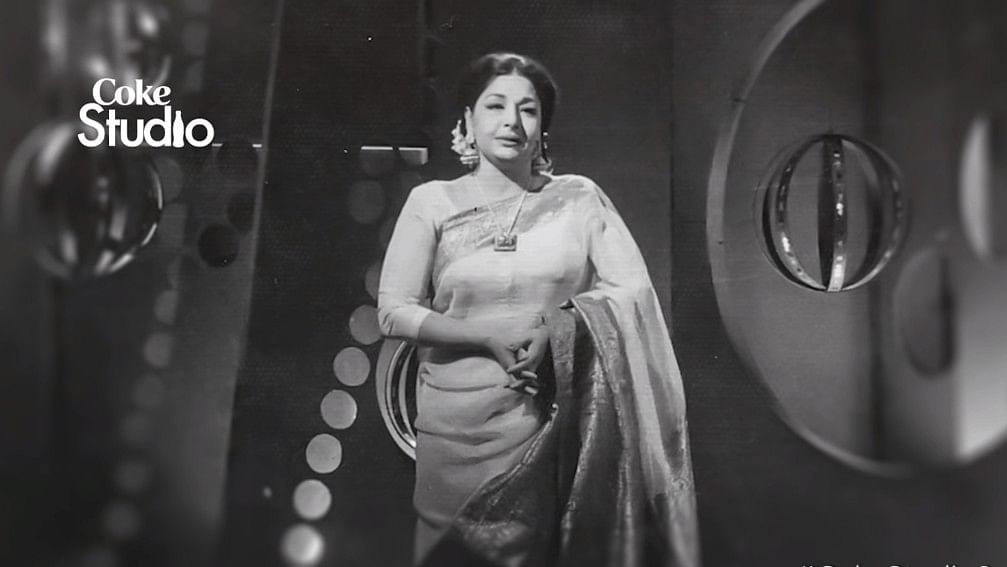
When Pranab Mukherjee, then external affairs minister, went to Pakistan in 2007, he had one request to his counterpart — he wanted to attend a performance by Farida Khanum. Mukherjee was not the only admirer of Malika-e-Ghazal (queen of ghazal) Farida Khanum. Among her countless admirers were Bade Ghulam Ali Khan, Noor Jehan and Lata Mangeshkar as well.
Khanum belonged to Amritsar. Lahore and Amritsar were twin cities with a shared culture. Calcutta (now Kolkata) in the east and Lahore-Amritsar in the west were the two cultural centres in north India before Partition. Khanum was a product of that rich culture.
Her elder sister, Mukhtar Begum, was a famous stage actor and singer. She was known as Bulbul-e-Punjab (Nightingale of Punjab). Mukhtar Begum was married to Agha Hashar Kashmiri, a fellow Amritsari, poet and dramatist. He was called the Shakespeare of Urdu. Thus, Khanum grew up with music, acting and dance at home. Even before her formal training began, she had started singing — emulating her sister and Akhtari Bai (Begum Akhtar). These were her early influences. Later she became a disciple of the renowned Ustad Aashiq Ali Khan of Patiala gharana. She also learnt from Ustad Barkat Ali Khan, the younger brother of Ustad Bade Ghulam Ali Khan.
Her grounding in Patiala gharana was complete. She became proficient in khayal, thumri and dadra. The Patiala gharana is characterised by fast taans, gamaks, meends, murkis and a touch of traditional Punjabi music, tappa and kaafi. It is not an easy style. Khanum became an adept at Patiala gharana singing. Along with disciplined riyaaz (practice of classical music), she worked on correct Urdu and Farsi pronunciation, which is necessary for a ghazal singer.
Having been influenced by her sister Mukhtar Begum, Begum Akhtar, Barkat Ali Khan and other exponents of ghazal and light classical music in her younger days, she was attracted to light classical music forms. But her guru Aashiq Ali Khan was against light music. He considered it a distraction. He wanted her to be a khayal and thumri singer. But destiny had charted a different path for her. Partition changed her life as it did for millions of others. The vibrant pre-partition culture of Lahore and Amritsar was devastated, never to recover.
Khanum’s family migrated to Pakistan from Amritsar. After moving to various places, they finally settled in Lahore. Finding her feet in a new place and earning a livelihood were immediate problems for 20-year-old Farida. Radio Pakistan, Lahore, came to her rescue. The legendary Ahmed Shah Bukhari, former director general of All India Radio, Delhi, had become head of Radio Pakistan. He recognised Khanum’s talent, her mastery in classical singing, and made her an ‘A grade’ artiste right away at that young age. So began her long association with Radio Pakistan. This gave her the chance to sing light classical music and ghazals which were her liking anyway. These forms were ideally suited for radio performances. Had Partition not happened, perhaps, under the influence of her guru Ustad Aashiq Ali Khan, she would have remained a khayal singer and become Malika-e-Khyal like Roshan Ara Begum, and not Malika-e-Ghazal.
Ghazal demands
The popularity of the ghazal form brought immense popularity to Khanum. Ghazal is a very demanding form with strict rules of rhyming and metre. If those rules are not followed, then the composition is not a ghazal. As in writing and singing, ghazal is a demanding form. (People writing ghazals in Kannada may kindly note). In ghazal singing, the emphasis is on the words.
Elaborate ornamentation, taans and sargam are not part of ghazal singing. It is just the word and the sur. Farida Khanum’s mastery of sur and her large range made her an eminent ghazal singer. All that she had learnt from Aashiq Ali Khan, Barkat Ali Khan and Bade Ghulam Ali Khan gave her singing depth. Her riyaz and tayyari were evident in her ghazal singing. And the emotional expression that she brought to it. The ghazal after all is an expression of emotions. Her impeccable stage presence was an asset.
Her famous song ‘Aaj jaane ki zid na karo’ is an example of how art can transmute the ordinary into the extraordinary. It is originally a film song, and not a ghazal, written by Fayaz Hashmi. But Khanum made it her own. No concert of hers was complete without this song.
Those who wish to enjoy Khanum’s ghazals should look for her renderings of Ghalib, Faiz Ahmed Faiz, Daagh and other great ghazal writers. Words and singing come together to give an unforgettable experience.
Farida Khanum has turned 95 now. What a musical journey it has been! We look forward to celebrating her birth centenary.